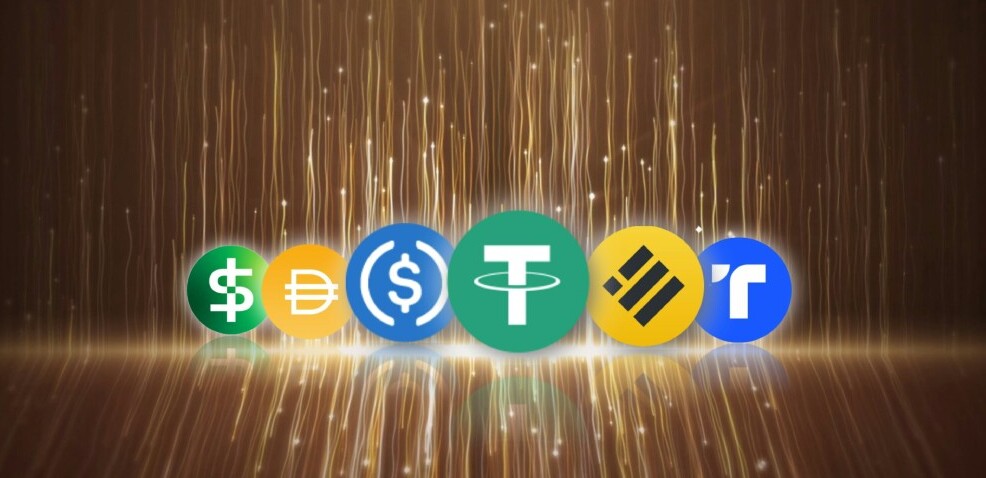The Rise Of Stablecoins
Stablecoins are the blend of digital excitement with old-school financial stability. Think of them as a digital currency that’s tied to something steady like the US dollar, making sure its value doesn’t jump around like some other cryptos. This way, you get the perks of cryptocurrency without the headache of wild price swings.

The trick with stablecoins is they’re pegged to real-world assets. USDT, also known as Tether, and USDC, USD Coin, are prime examples in this game. They aim to maintain a 1:1 value ratio with the US dollar, meaning for every digital coin, there’s an equivalent dollar or asset held somewhere safe to back it up.
So, why are these connections important? They create trust in these digital coins. People can use them just like regular money, but with the added benefit of operating in the digital realm. No more worrying about the dramatic ups and downs typical of traditional cryptos.
USDT and USDC have carved out their own spaces. USDT is like the all-time favourite in the crypto world, especially when traders want to keep their funds stable amidst volatile market conditions. USDC, on the other hand, is known for its transparency. It undergoes regular audits, so users know that the backing reserves are legit.
The takeaway here? Stablecoins bring together the best of both worlds—digital currency’s innovation and traditional money’s reliability. They’re setting a new standard for how we interact with digital finance, making it easier for anyone to jump on board without the rollercoaster ride of value changes.
Benefits Over Traditional Fiat: Why Choose Stablecoins?
Stablecoins offer a fresh twist on how you handle money. While traditional fiat currencies like the dollar have been around for ages, stablecoins introduce a bunch of handy benefits that make them worth checking out.

One of the biggest perks? Stability in an unpredictable market. Cryptocurrencies are notorious for their wild price swings, but stablecoins hold their ground by being pegged to stable assets. This keeps the value steady, reducing the anxiety of constant price checks. Use them to send or receive money, and you’ll find the value consistent without any crazy surprises.
Next up, financial inclusivity. Stablecoins are breaking down barriers for people who don’t have easy access to banks, especially in places where traditional banking is either expensive or straight-up unavailable. With just a smartphone and internet connection, anyone can become part of the global economy, sending and receiving payments without those hefty transaction fees banks often charge.
Speed is another winning factor. Anyone who’s dealt with international money transfers knows it can sometimes feel like you’re waiting for paint to dry. With stablecoins, transactions across borders happen almost instantly. Gone are the waiting days and the bureaucracy of bank clearances. Say goodbye to expensive exchange rates and delays.
The icing on the cake? Reduced transaction costs. Unlike traditional mechanisms that might take a chunk out of your transfer, stablecoins offer cheaper alternatives. This opens the door for micro-transactions too, which would otherwise get eaten up by fees when using regular money.
In short, these digital assets offer solutions that make daily transactions smoother and more accessible. You’re not just sticking to the old ways—you’re embracing a hybrid of new technology that makes everyday financial tasks easier and more efficient.
A Glimpse into the Future: The Long-term Potential of Stablecoins
Stablecoins are not just a passing trend. They’re shaping up to be major players in the financial landscape of tomorrow. One of the most exciting areas where they’re making waves is decentralised finance, or DeFi as it’s commonly known. Picture a whole financial world running on the blockchain, where stablecoins are the bridge providing stability and trust.

This integration with DeFi isn’t just for show. It opens up avenues like lending, borrowing, and even earning interest, all without involving a traditional bank. The transparency and efficiency of blockchain tech combined with stablecoins’ steadiness are like a match made in digital heaven.
Now, the legal side of things: as with all new financial tools, regulation plays a big role. The good news is, regulators are beginning to recognise the promise stablecoins hold. Governments and financial institutions are working to create frameworks that protect users without stifling innovation. This regulatory recognition is crucial as it balances security with the freedom stablecoins provide.
Looking ahead, stablecoins could very well act as a stepping stone for wider digital currency adoption. They serve as an accessible entry point for people curious about digital assets but wary of the volatility in cryptocurrencies like Bitcoin or Ethereum.
In the grand scheme of things, stablecoins are merging the best parts of the old-school money system with the benefits of digital currency. They’re not just about maintaining stability but also about revolutionising how we perceive and use currencies on a global scale. Their role is continuously evolving, promising a future where money isn’t just paper and coins but a fluid, efficient, and globally inclusive digital instrument.
Comparing Leaders: The Roles of USDT and USDC in the Stablecoin Ecosystem
USDT, or Tether, is like the go-to name in the stablecoin scene. It’s been around for a while and is often the choice for traders and investors looking to avoid the ups and downs of traditional cryptos. Its widespread use is a testament to its reliability, though it hasn’t been without its controversies, mainly around its backing reserves.

On the flip side, USDC, or USD Coin, is gaining ground fast due to its clear-cut approach and regular audits that bolster trust. Its operation is based on transparency, offering clarity through regular reports that showcase its reserves matching the circulating supply. For users who prioritise transparency, USDC is rapidly becoming a favourite.
Both these stablecoins, while serving a similar fundamental purpose, play different roles based on what users value most—widespread adoption versus operational transparency.
However, it’s not all smooth sailing for either of them. They both face challenges, especially as governments hone in on regulation. Scalability and regulatory compliance are ongoing concerns. Balancing these challenges while maintaining user trust is crucial for their sustained growth.
In this evolving space, USDT and USDC represent the versatility and robustness of stablecoins. Whether you lean on widespread acceptance or favour detailed audits, these stablecoins are shaping the way forward in the digital currency landscape, creating new opportunities every day.
Sign up for further updates
Follow us here on X for regular updates…..
Nothing within this blog constitutes financial advice. We strongly encourage you to conduct your own research (DYOR) before making any investment decisions. Always invest wisely and never invest more than you can afford to lose.















2 Responses
Stablecoins are becoming such a cornerstone of the crypto ecosystem, and it’s fascinating to see how they’re shaping the future of digital finance. One thing I find intriguing is their role in bridging the gap between traditional finance and crypto, particularly in emerging markets where they can provide a more stable alternative to local currencies. However, with increasing regulatory scrutiny, how do you see their adoption evolving? Do you think decentralized stablecoins will gain more traction compared to centralized ones in the long run, or will regulations push users toward more centralized solutions?
Thank you for your thoughtful review! We completely agree that stablecoins play a vital role in bridging traditional finance and crypto, especially in emerging markets. Their stability can indeed provide a safer alternative to volatile local currencies.
Regarding your questions, we believe the adoption of stablecoins will continue to evolve as regulatory frameworks become clearer. While regulatory scrutiny might initially favour centralised solutions for compliance and security reasons, decentralised stablecoins could gain traction among users seeking autonomy and lower risks of censorship. In the long run, it may depend on how well each type addresses regulatory concerns while meeting users’ needs for security and stability. It will be fascinating to see how this dynamic unfolds especially in 2025!
KR
GoTradeCrypto Team